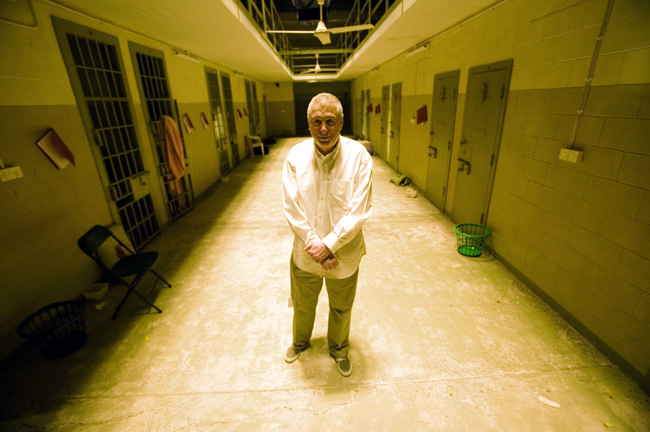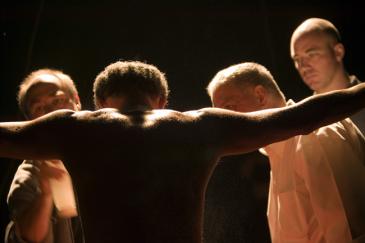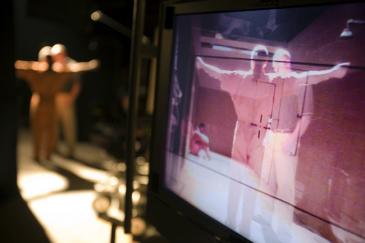CHICAGO – Patrick McDonald of HollywoodChicago.com appears on “The Morning Mess” with Dan Baker on WBGR-FM (Monroe, Wisconsin) on March 21st, 2024, reviewing the new streaming series “Manhunt” – based on the bestseller by James L. Swanson – currently streaming on Apple TV+.
Interview: ‘Standard Operating Procedure’ Director Errol Morris Discusses Evil From Iraqi Prison
CHICAGO – Here is the legendary documentarian Errol Morris on the infamous 2003 photographs taken at the Abu Ghraib prison in Iraq, which are the subject of his new film entitled “Standard Operating Procedure”:
There was another bad thing about the photographs. They led into a kind of weird dogmatism: ‘Oh, I know what is in that photograph. I understand what is in that photograph. [Sic] you. It means this or no it doesn’t it means that. Whatever.’
You can’t just do that. Investigation is therapy. You have to investigate. You have to make an effort to find out (not once and for all) but you have to – to the best of your abilities – ascertain what was going on.
 Photo credit: Nubar Alexanian | © 2007 Max Ave Productions | Courtesy of Sony Pictures Classics |
 This latest film is an intense and sorrowful examination of the morality behind these infamous digital pictures. Most of them depict American soldiers conducting bizarre prisoner-humiliation procedures including the iconic black-hooded detainee on a box photo and soldier Lynndie England’s “cigarette” picture with naked Iraqi prisoners.
This latest film is an intense and sorrowful examination of the morality behind these infamous digital pictures. Most of them depict American soldiers conducting bizarre prisoner-humiliation procedures including the iconic black-hooded detainee on a box photo and soldier Lynndie England’s “cigarette” picture with naked Iraqi prisoners.
 Photo credit: Nubar Alexanian | © 2007 Max Ave Productions | Courtesy of Sony Pictures Classics |
Morris interviews most of the key military personnel who were involved at Abu Ghraib, the soldiers who took the pictures, the soldiers who posed so callously with their charges and the investigators who were called upon to make sense of the mess.
HollywoodChicago.com on April 15, 2008 interviewed Morris in Chicago to gain insight into his powerful new film.
“Everybody dumps on the [soldier participants] and dumps on the bad apples,” Morris said in our interview. “As far as everyone is concerned, they are evil. Evil. Evil. Evil. End of discussion.”
He added: “The left wing says they are evil because of Donald Rumsfeld, Dick Cheney and George Bush. The right wing says it’s because they are just evil, rogue soldiers. You need to go into the story. You need to do more than just posture.”
Through the interviews and dissection, the pictures are presented starkly and uncensored. There’s a fascinating overview of the detective work that was done to discover the order in which the pictures were taken and an examination into the nature of what we see when presented with a photographic image.
 Photo credit: Patrick McDonald, HollywoodChicago.com |
Morris explains this phenomenon through the picture of sergeant Sabrina Harmon: an Abu Ghraib guard who took a picture with the beaten corpse of a dead Iraqi prisoner.
“You see the smile,” Morris said, “and you don’t see the murder. The fact [that] there is a body in the frame [means] Sabrina didn’t kill him. Sabrina didn’t try to cover up the murder. They took a picture of the corpse.”
 Photo credit: Nubar Alexanian | © 2007 Max Ave Productions | Courtesy of Sony Pictures Classics |
Morris continued: “That’s pretty amazing – that we see the picture one way and yet the picture shows us something really different. My catch-all phrase is that photographs reveal and conceal. They do both and they do both at the same time.”
The most famous interviewee – private Lynndie England (now on parole after serving part of a three-year sentence) – surprised Morris the most.
“In anticipation [of] the day we interviewed her, [England] was a person described as a ‘hillbilly’. She was mentally deficient,” Morris recalled. “She comes into the studio, we don’t know what to expect and she turns out to be perfectly articulate. I can tell you – no ifs, ands or buts – we were all shocked. Just plain shocked.”
Morris added: “One of England’s speeches in the film includes the line: ‘It’s drama. It’s life.’ She says it right together as if she’s making that connection for herself. It’s very powerful, very disturbing and a very sad interview.”
While reenactments – an Errol Morris trademark in his documentaries – are a controversial tool, he feels they best convey emotion.
RELATED IMAGE GALLERY View our high-resolution “Standard Operating Procedure” image gallery. View our high-resolution “Standard Operating Procedure” image gallery.RELATED AUDIO CLIP  Listen to our clip with Errol Morris on a filming trade secret. Listen to our clip with Errol Morris on a filming trade secret.RELATED READING  Read more film reviews from critic Patrick McDonald. Read more film reviews from critic Patrick McDonald. |
“It is [probably] a mistake to call them reenactments,” Morris countered, “but I can tell you the images to me that are really powerful. [There’s] the drop of blood on (Abu Ghraib guard sergeant Tony) Diaz’s uniform when he’s wrestling with the question: ‘Am I involved in this?’ I feel Diaz looking at his uniform like Lady MacBeth. He’s looking at the spot of blood and wondering what it means.”
Morris tackled the subject – among the mass of recent Iraq war documentaries – because he “wasn’t sure anyone else would tell it if I didn’t tell it”. There was something he saw in the photographs and the shocking admission of one of the major witnesses when he actually interviewed the participants.
Morris added: “When I look at a photograph from Abu Ghraib, am I looking at policy? Am I looking at just the actions of a few lone soldiers? To me, it was really powerful when one of the major government witnesses tells you that the iconic picture of torture and abuse in the Iraq war (the black-hooded picture) is standard operating procedure for U.S. prisoner interrogation.”
How does Morris sum up the “fog of war” in Iraq in association with the Abu Ghraib photographs?
“We have picked scapegoats and haven’t really been able to understand this war. That is unfortunate,” he said. “The war has been costly in the sense that it has completely undermined what is great about America. Somebody has to acknowledge that fact and start to make it right.”
More From Errol Morris
On his notorious film and interview subject “Dr. Death”:
I once read that ‘art is extending compassion where it has never been extended before’. There is some truth to that. I do like the idea of these people who are utter pariahs.
Fred Leuchter is beyond the pale in many, many ways. An electric-chair repairman and designer and a Holocaust denier, Fred has a lot of politically incorrect notions floating around in his head. For large groups of people, that limits his social acceptability.
But I like Fred. I found him endlessly fascinating. I don’t understand Fred, but I find him to be one of my all-time favorite characters.
On working with famed soundtrack artist and writer of “The Simpsons” theme Danny Elfman:
Danny is a great collaborator. He is really a fabulous person to work with and this will not be the last film [we] do together. We like working together. I’m saying something completely obvious. He knows how to write for movies.
In a way, it’s defeating some of those impulses not to score immediately to underline emotion or specific content of a scene. He wrote a lot of cues. He allowed me to spot them in different places once I had spotted them.
He then developed them and made them work better. It was a back and forth constantly. It was fast and good. I love the guy.
Finally, on his future projects:
I wanted to do another version of ‘Fast, Cheap & Out of Control’. I wanted to go back to something more romantic and quirky and funny.
I’d like to do a hybrid film: a documentary and a narrative. If I could get the right actors and the right amount of money, I’m going to have a go at it.
 | By PATRICK McDONALD |


